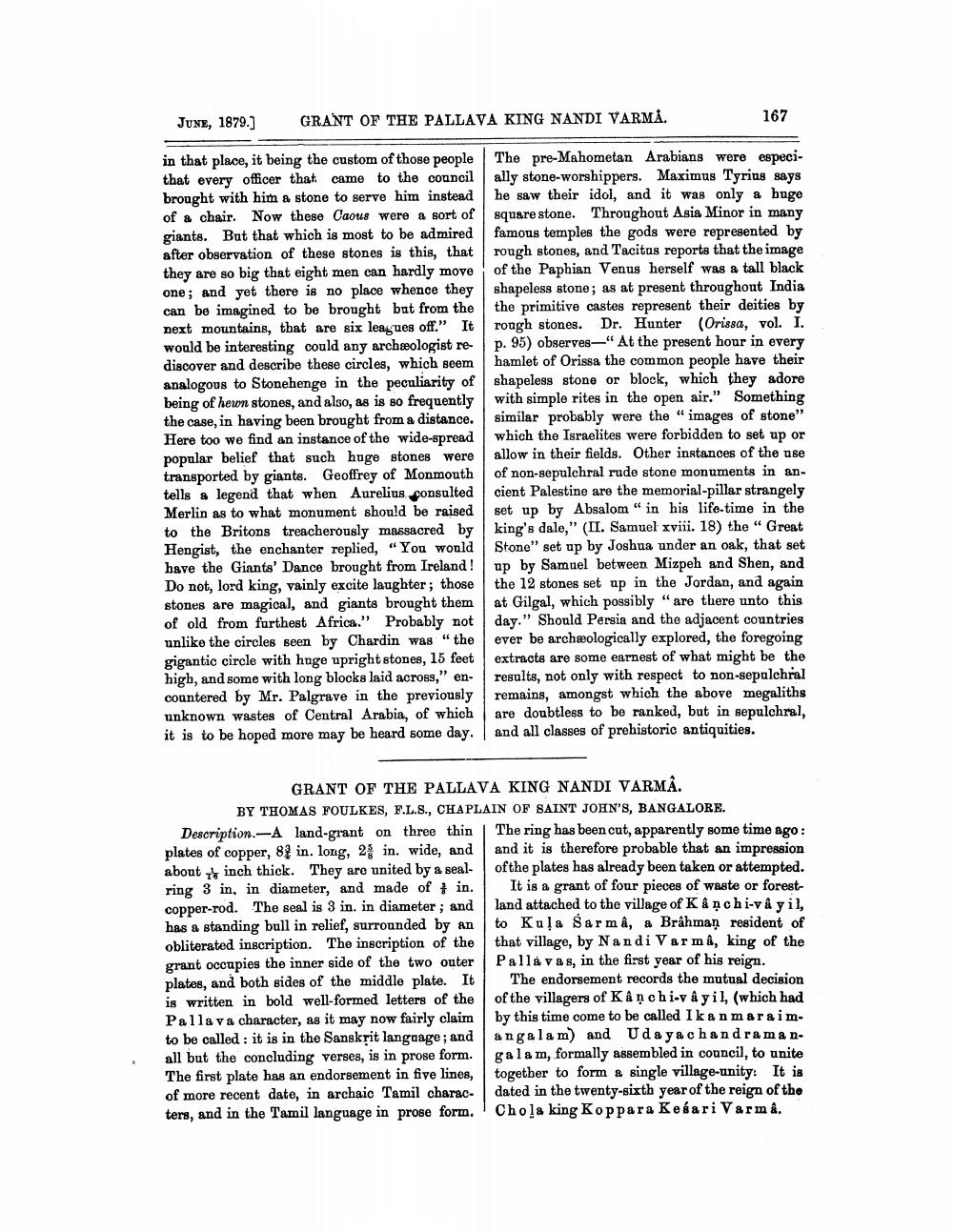________________
JUNE, 1879.)
GRANT OF THE PALLAVA KING NANDI VARMÅ.
167
in that place, it being the custom of those people The pre-Mahometan Arabians were especithat every officer that came to the council ally stone-worshippers. Maximus Tyrins says brought with him a stone to serve him instead he saw their idol, and it was only a huge of a chair. Now these Caous were a sort of square stone. Throughout Asia Minor in many giants. But that which is most to be admired famous temples the gods were represented by after observation of these stones is this, that rough stones, and Tacitus reports that the image they are so big that eight men can hardly move of the Paphian Venus herself was a tall black one; and yet there is no place whence they shapeless stone; as at present throughout India can be imagined to be brought bat from the the primitive castes represent their deities by next mountains, that are six leagues off." It rough stones. Dr. Hunter (Orissa, vol. I. would be interesting could any archæologist rep. 95) observes—" At the present hour in every discover and describe these circles, which seem hamlet of Orissa the common people have their analogous to Stonehenge in the peculiarity of shapeless stone or block, which they adore being of hewn stones, and also, as is so frequently
with simple rites in the open air." Something the case, in having been brought from a distance. similar probably were the "images of stone" Here too we find an instance of the wide-spread which the Israelites were forbidden to set up or popular belief that such huge stones were allow in their fields. Other instances of the use transported by giants. Geoffrey of Monmouth of non-sepulchral rude stone monuments in antells a legend that when Aurelius consulted cient Palestine are the memorial-pillar strangely Merlin as to what monument should be raised set up by Absalom " in his life-time in the to the Britons treacherously massacred by king's dale," (II. Samuel xviii. 18) the “Great Hengist, the enchanter replied, “You would Stone" set up by Joshua under an oak, that set have the Giants' Dance brought from Ireland! up by Samuel between Mizpeh and Shen, and Do not, lord king, vainly excite laughter; those the 12 stones set up in the Jordan, and again stones are magical, and giants brought them at Gilgal, which possibly " are there unto this of old from furthest Africa." Probably not day." Should Persia and the adjacent countries unlike the circles seen by Chardin was "the ever be archeologically explored, the foregoing gigantic circle with huge upright stones, 15 feet extracts are some earnest of what might be the high, and some with long blocks laid across," en results, not only with respect to non-sepulchral countered by Mr. Palgrave in the previously remains, amongst which the above megaliths unknown wastes of Central Arabia, of which are doubtless to be ranked, but in sepulchral, it is to be hoped more may be heard some day. and all classes of prehistoric antiquities.
GRANT OF THE PALLAVA KING NANDI VARMA. BY THOMAS FOULKES, F.L.S., CHAPLAIN OF SAINT JOHN'S, BANGALORE. Description.- A land-grant on three thin | The ring has been cut, apparently some time ago : plates of copper, 84 in. long, 2 in. wide, and and it is therefore probable that an impression about to inch thick. They are united by a seal of the plates has already been taken or attempted. ring 3 in, in diameter, and made of in. It is a grant of four pieces of waste or forestcopper-rod. The seal is 3 in. in diameter; and land attached to the village of Kanchi-vå yil, has a standing bull in relief, surrounded by an to Kula Sarma, a Brâhman resident of obliterated inscription. The inscription of the that village, by Nandi Varma, king of the grant occupies the inner side of the two outer Palla vas, in the first year of his reign. plates, and both sides of the middle plate. It | The endorsement records the mutual decision is written in bold well-formed letters of the of the villagers of Kanchi-v âyil, (which had Pallava character, as it may now fairly claim by this time come to be called Ikanmaraimto be called : it is in the Sanskrit language; and angalam) and Udayachandraman. all but the concluding verses, is in prose form. galam, formally assembled in council, to unite The first plate has an endorsement in five lines, together to form a single village-unity. It is of more recent date, in archaic Tamil charac. dated in the twenty-sixth year of the reign of the ters, and in the Tamil language in prose form.Chola king Koppara Kesari Varma.




